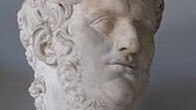Archaeologists find theatre where Nero ‘fiddled’ as Rome burnt
Archaeologists believe they have found the remains of the emperor Nero’s private theatre under a garden in a Renaissance palace next to the Vatican.

Archaeologists believe they have found the remains of the emperor Nero’s private theatre under a garden in a Renaissance palace next to the Vatican.
The discovery presented in the Palazzo della Rovere on Wednesday (Thursday AEST) reveals the brick and marble surroundings in which Nero, remembered as the ruler who fiddled while Rome burnt, might have plucked his lyre and recited poetry to invited audiences.
“This is an exceptionally important discovery which reveals an extraordinary building from the Julio-Claudian era, the theatre where Nero practised his poetic recitations and songs, which was known from ancient sources but had never been found,” Daniela Porro, Rome’s chief archaeologist, said.
The excavation site was originally part of the pleasure gardens of Agrippina the Elder, situated near a circus built by the emperor Caligula for private chariot races. Today it is a vast pit in a courtyard of the 15th-century palazzo, which was given by Pope Pius XII to the Order of the Holy Sepulchre in 1950. The site will eventually be reburied and become part of a wing rented out to the Four Seasons hotel chain.
The existence of Nero’s theatre was documented by the historians Pliny the Elder, Suetonius and Tacitus.
Archaeologists believe they have found part of the seating area, some of the stage and store rooms. Alessio De Cristofaro, one of those who oversaw the excavation, said the theatre shared the luxury finishings associated with Nero’s lavish Domus Aurea (Golden House). Among the finds was a double-headed bust of Janus, the Roman god.
“It had a significant capacity, probably for an audience of several thousand,” De Cristofaro said. “There were fluted columns in African marble, alabaster columns and stucco ornamentation decorated with gold leaf.”
Date stamps on bricks confirmed the age of the theatre, which is believed to have been pillaged for building materials in the early part of the 2nd century. Archaeologists surmised, by interpreting a passage from Tacitus, that Nero had reflected on the disastrous fire of AD64 by reciting Homer’s verses on the fall of Troy at the venue.
Caligula and Nero had been depicted as mad tyrants, De Cristofaro said, but Nero “was a great governor and responsible for important economic reforms. His theatrical performances were not just a self-representation of power but an attempt to mould society”.
Marzia Di Mento, who supervised the dig, said: “Everything we find will go on display in the palazzo.”
The Times


